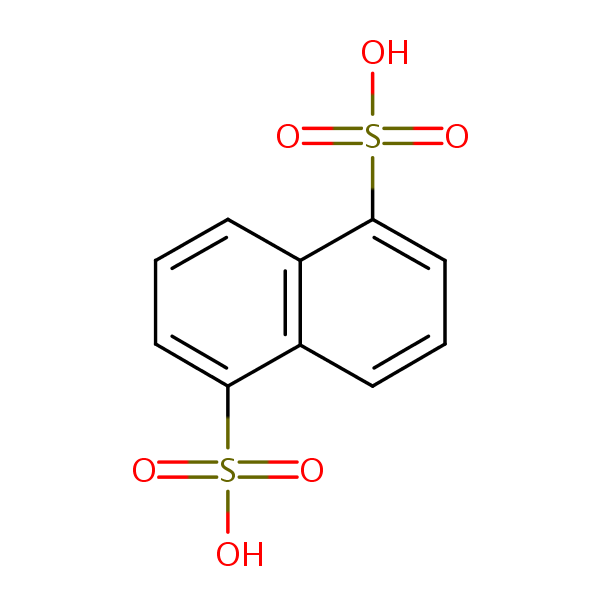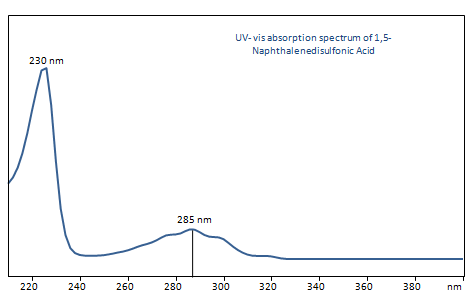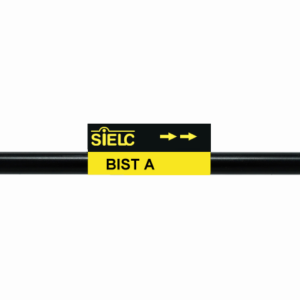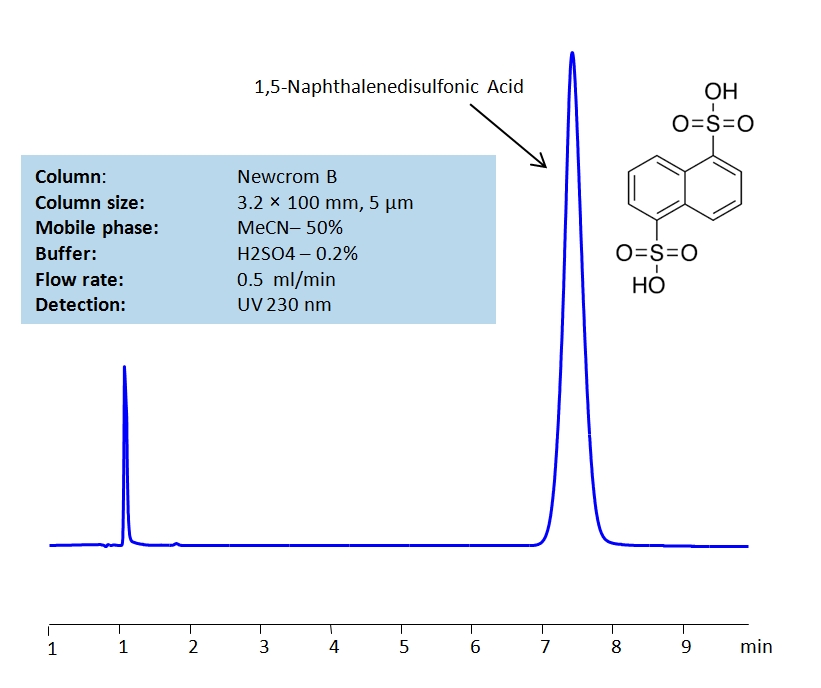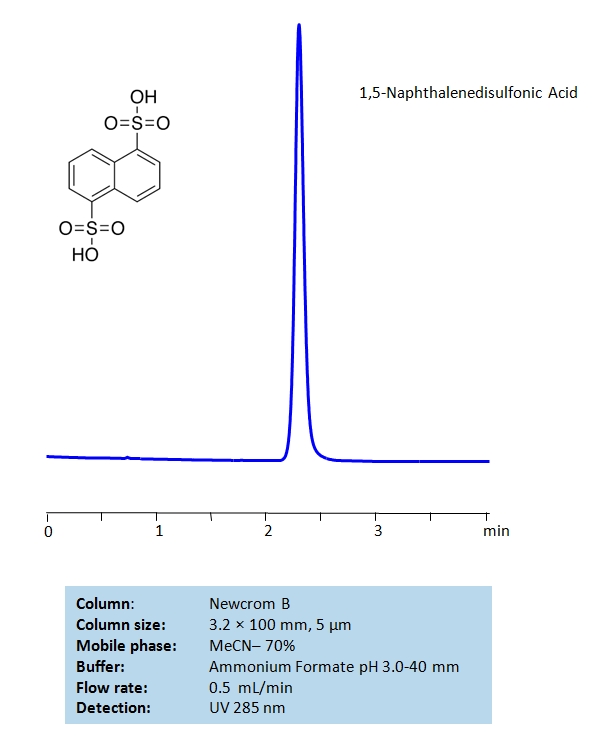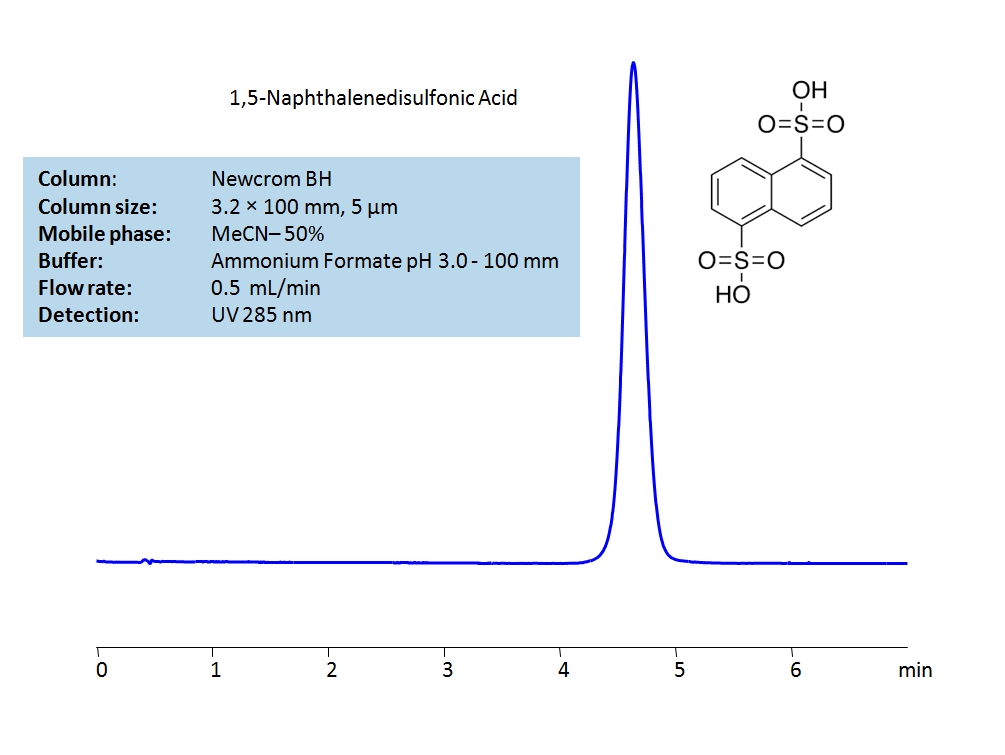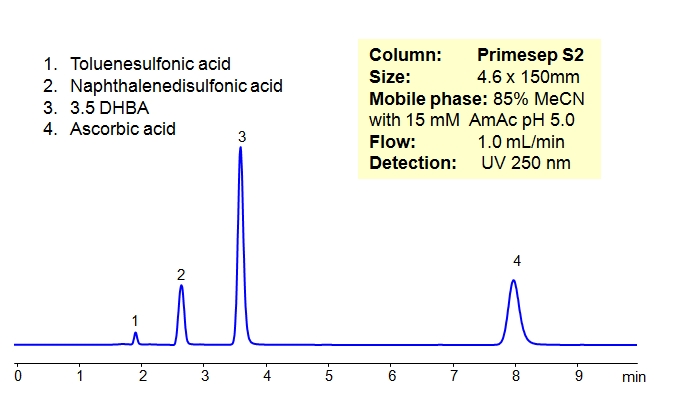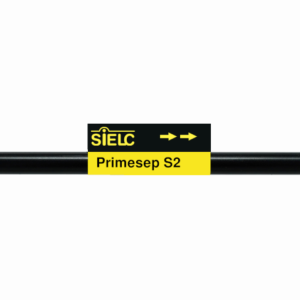| CAS Number | 81-04-9 |
|---|---|
| Molecular Formula | C10H8O6S2 |
| Molecular Weight | 288.291 |
| InChI Key | XTEGVFVZDVNBPF-UHFFFAOYSA-N |
| LogP | -0.262 |
| Synonyms |
|
Applications:
HPLC Method for Analysis of 2 – Naphthalenesulfonic acid and 1,5 -Naphthalenedisulfonic acid on BIST A Column
December 1, 2022
HPLC Method for Analysis of 2-Naphthalenesulfonic Acid, 1,5-Naphthalenedisulfonic Acid on BIST A Column by SIELC Technologies
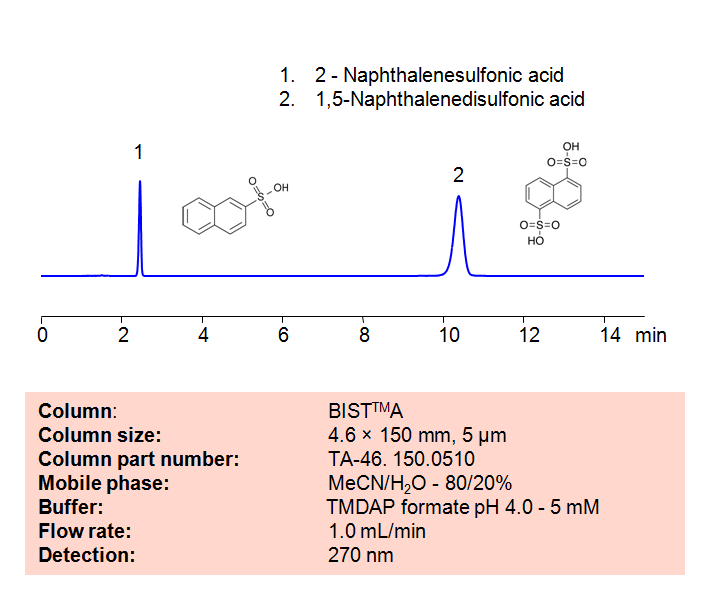
2-Naphthalenesulfonic acid and 1,5-Naphthalenedisulfonic acid, also known as Armstrong’s acid, are two similarly-structured compounds. 2-Naphthalenesulfonic acid is commonly used in dye production and 1,5-Naphthalenedisulfonic acid is used in synthesizing the salts of basic drugs and in electrokinetic chromatography.
2-Naphthalenesulfonic Acid is an organic compound with the formula C10H7SO3H. It is used primarily in the production of dyes, but has also historically been industrially used for a it’s various chemical reactions.
1,5-Naphthalenedisulfonic acid is a strong organic acid with a double charge. It has the chemical formula C10H8S2O6.
Using SIELC’s newly introduced BIST™ method, these two acids can be retained on a negatively-charged, cation-exchange BIST A. There are two keys to this retention method: 1) a multi-charged, positive buffer, such as N,N,N’,N’-Tetramethyl-1,3-propanediamine (TMDAP), which acts as a bridge, linking the negatively-charged tartrazine analytes to the negatively-charged column surface and 2) a mobile phase consisting mostly of organic solvent to minimize the formation of a solvation layer around the charged analytes. Using this new and unique analysis method, 2-Naphthalenesulfonic acid and 1,5-Naphthalenedisulfonic acid can be retained and UV detected at 270 nm.
Condition
| Column | BIST A, 4.6 x 150 mm, 5 µm, 100 A, dual ended |
| Mobile Phase | MeCN – 80/20% |
| Buffer | TMDAP formate pH 4.0 – 5,0 mM |
| Flow Rate | 1.0 ml/min |
| Detection | 270 nm |
Description
| Class of Compounds | Acid, Sulfonic acid |
| Analyzing Compounds | 2-Naphthalenesulfonic Acid, 1,5-Naphthalenedisulfonic Acid |
Application Column
BIST A
Column Diameter: 4.6 mm
Column Length: 150 mm
Particle Size: 5 µm
Pore Size: 100 A
Column options: dual ended
2-Naphthalenesulfonic Acid

HPLC Determination of 1,5-Naphthalenedisulfonic Acid on Newcrom B Column
March 2, 2021
HPLC Method for 1,5-Naphthalenedisulfonic Acid on Newcrom B by SIELC Technologies
| Column | Newcrom B, 3.2 x 100 mm, 5 µm, 100 A, dual ended |
| Mobile Phase | MeCN/H2O – 50/50% |
| Buffer | H2SO4 – 0.2% |
| Flow Rate | 0.5 ml/min |
| Detection | UV 230nm |
High Performance Liquid Chromatography (HPLC) Method for Analysis of 1,5-Naphthalenedisulfonic Acid.
1,5-Naphthalenedisulfonic acid, also known as Armstrong’s acid, is a strong organic acid with a double charge. It has the chemical formula C10H8S2O6.
Multi-charged molecules generally have a tendency to exhibit poor peak shape in HPLC on reverse-phase columns showing significant tailing. 1,5-Naphthalenedisulfonic Acid can be retained with great peak shape on a Newcrom B mixed-mode column. The Newcrom line of columns was designed specifically for improved peak shape of multi-charged molecules. The method uses a mobile phase consisting of acetonitrile (ACN), water and ammonium formate buffer, making the method MS-compatible. UV detection at 260nm can also be used.
| Column | Newcrom B, 3.2 x 100 mm, 5 µm, 100 A, dual ended |
| Mobile Phase | MeCN/H2O – 70/30% |
| Buffer | Ammonium Formate pH 3.0 – 40 mM |
| Flow Rate | 0.5 ml/min |
| Detection | UV 285 nm |
| Class of Compounds | Acid |
| Analyzing Compounds | 1,5-Naphthalenedisulfonic Acid |
Application Column
Newcrom B
Column Diameter: 3.2 mm
Column Length: 100 mm
Particle Size: 5 µm
Pore Size: 100 A
Column options: dual ended

HPLC Determination of 1,5-Naphthalenedisulfonic Acid on Newcrom BH Column
June 25, 2020
HPLC Method for 1,5-Naphthalenedisulfonic Acid on Newcrom BH by SIELC Technologies
High Performance Liquid Chromatography (HPLC) Method for Analysis of 1,5-Naphthalenedisulfonic Acid.
1,5-Naphthalenedisulfonic acid is a strong organic acid with a double charge. Multi-charged molecules generally have a tendency to exhibit poor peak shape in HPLC on reverse-phase columns showing significant tailing. The acid can be retained with great peak shape on a Newcrom BH mixed-mode column. The Newcrom line of columns was designed specifically for improved peak shape of multi-charged molecules. The method uses a mobile phase consisting of acetonitrile (ACN), water and ammonium formate buffer, making the method MS-compatible. UV detection at 260nm can also be used.
| Column | Newcrom BH, 3.2 x 100 mm, 5 µm, 100 A, dual ended |
| Mobile Phase | MeCN/H2O – 50/50% |
| Buffer | Ammonium Formate – 100 mM, pH 3.0 |
| Flow Rate | 0.5 ml/min |
| Detection | UV 285 nm |
| Class of Compounds | Acid |
| Analyzing Compounds | 1,5-Naphthalenedisulfonic Acid |
Application Column
Newcrom BH
Column Diameter: 3.2 mm
Column Length: 100 mm
Particle Size: 5 µm
Pore Size: 100 A
Column options: dual ended

HPLC Separation of Organic Acids in HILIC and Anion-Exclusion Mode on Primesep S2 Column
July 14, 2011
Organic acids were separated on a HILIC/cation-exchange column in HILIC/anion-exclusion mode. This column can be used for analysis of polar compounds in HILIC mode. If compounds are ionizable, additional mode of interaction can be added (cation-exchange or anion-exclusion).
| Column | Primesep S2, 4.6×150 mm, 5 µm, 100A |
| Mobile Phase | MeCN/H2O – 85/15% |
| Buffer | AmAc pH 5.0 15 mM |
| Flow Rate | 1.0 ml/min |
| Detection | ELSD, 50C UV 250 nm |
| Class of Compounds |
Nucleosides, Hydrophilic, Ionizable |
| Analyzing Compounds | Toluenesulfonic acid, Naphthalenedisulfonic acid, 3.5 DHBA, Ascorbic acid, |
Application Column
Primesep S2
The Primesep family of mixed-mode columns offers a wide variety of stationary phases, boasting unprecedented selectivity in the separation of a broad array of chemical compounds across multiple applications. Corresponding Primesep guard columns, available with all stationary phases, do not require holders. SIELC provides a method development service available to all customers. Inquire about our specially-tailored custom LC-phases for specific separations.
Select options3,5-Dihydroxybenzoic Acid
Ascorbic Acid
Organic Acids
p-Toluenesulfonic Acid (PTSA)

HILIC Retention of 1,5-Naphthalenedisulfonic Acid on Obelisc N Mixed-Mode HILIC Columns
July 16, 2009
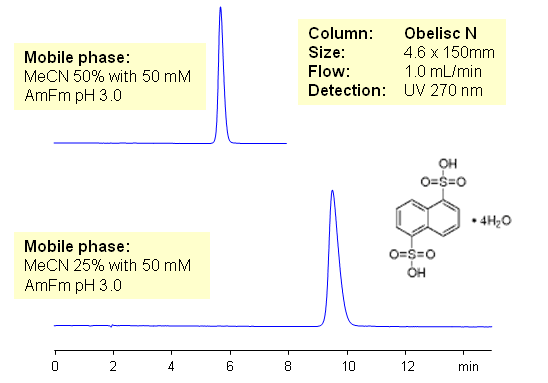
Naphthalenedisulfonic acid is retained by anion-exchange mechanism on Obelisc N mixed-mode HILIC column. Retention time is controlled by amount of ion in the mobile phase. Method demonstrates very good peak shape and controllable retention. This mixed-mode approach can be used for quantitation of various sulfonic acid in different matrices. UV, ELSD or LC/MS can be used for quantitation.
| Column | Obelisc N , 4.6×150 mm, 5 µm, 100A |
| Mobile Phase | MeCN/H2O |
| Buffer | AmFm pH 3.0 |
| Flow Rate | 1.0 ml/min |
| Detection | UV, 270 nm |
| Class of Compounds |
Acid |
| Analyzing Compounds | 1,5-Naphthalenedisulfonic Acid |
Application Column
Obelisc N
SIELC has developed the Obelisc™ columns, which are mixed-mode and utilize Liquid Separation Cell technology (LiSC™). These cost-effective columns are the first of their kind to be commercially available and can replace multiple HPLC columns, including reversed-phase (RP), AQ-type reversed-phase, polar-embedded group RP columns, normal-phase, cation-exchange, anion-exchange, ion-exclusion, and HILIC (Hydrophilic Interaction Liquid Chromatography) columns. By controlling just three orthogonal method parameters - buffer concentration, buffer pH, and organic modifier concentration - users can adjust the column properties with pinpoint precision to separate complex mixtures.
Select optionsSulfonic Acid
UV Detection

